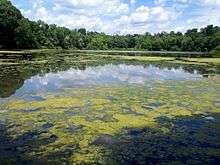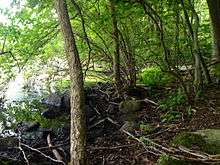Lake Shenorock

Lake Shenorock is a lake located in the hamlet of Shenorock in the town Somers, New York. The lake is used for fishing and was used for recreational swimming until the Clean Water Act was passed and the lake became a source of drinking water. The Clean Water Act was passed in 1972, recreational swimming ended in 1977. The lake is part of the Croton Reservoir System and is a tributary to the Amawalk Reservoir, which is used as a source of water for New York City residents.[1] There are no major tributaries to the class B lake.
- Basin: Lower Hudson River
- Size: 5.2 hectares (12.8 acres)
- Lake Origins: Augmented by Dam
- Watershed Area: 400 hectares (988 acres)
- Mean Depth: 1.1 meters
- Sounding Depth: 2.3 meters
Geography
Lake Shenorock is located at 41°19′55″N 73°44′22″W / 41.33194°N 73.73944°W (41.331850, -73.739323).[2] Lake Shenorock is located North of the Amawalk Reservoir
Lake uses
Lake Shenorock is classified as a class B lake, its intended use is for swimming. A beach, cement dock and dam can be found on the shore of the lake. Swimming is now banned and Lake Shenorock is used for recreation fishing. The recreational uses are considered to be impaired due to algae and poor water transparency. High levels of phosphorus greatly contribute to the algal growth, low levels of oxygen, and poor water transparency.[3]
Wildlife
The state of New York does not stock the lake with fish. Lake Shenorock is a warmwater fishery environment that is home to largemouth bass, crappie, sunfish, catfish, and other wildlife such as duck, swan, chelydridae, canada goose, and even muskrat.[4] These are just some of species that inhabit the lake ecosystem, there has been no scientific documentation of the species that live in the lake ecosystem.
Recreational usage
Lake Shenorock once supported two beaches but they were closed in 1977 so that it could be used as a backup supply for the Amawalk and Shenorock water district and tributary to the Amawalk Reservoir. The current association, the United Owners Association of Shenorock, submitted a proposal to the Somers Town Board to create a Park District where recreational swimming would be able to return to the lake after renditions to the Lake were made. Due to the Eutrophic condition of the lake and lack of a clubhouse, restoration projects such as dredging and installment of aeration devies would need to be implemented to enable recreational swimming.[3] For more information on the proposal visit the Shenorock Park District YouTube page.[5]
Health

The lake is currently undergoing a eutrophic process at a faster rate due to the run off of fertilizers that contain chemicals such as Phosphorus.[6] This is causing the lake to undergo the natural process of transitioning into a swamp at a faster rate.[7]
Water flow
Lake Shenorock has no named tributaries but water released from Lake Shenorock flows into the Amawalk Reservoir. Water which is either released out of Amawalk Reservoir flows south in the Muscoot River and eventually enters the Muscoot Reservoir, and then flows into the New Croton Reservoir. The water enters the New Croton Aqueduct, which sends water to the Jerome Park Reservoir in the Bronx, where the water is distributed to the Bronx and to northern Manhattan. On average, the New Croton Aqueduct delivers 10% of New York City's drinking water.[8] The water that doesn't enter the New Croton Aqueduct will flow into the Hudson River at Croton Point.
References
- ↑ Linsey, K. S., Wolcott, S. W., & Schoonmaker, N. B. (1999). Identification of potential water-resources-monitoring sites in the Croton Reservoir system, southeastern New York. US Department of the Interior, US Geological Survey.
- ↑ "US Gazetteer files: 2010, 2000, and 1990". United States Census Bureau. 2011-02-12. Retrieved 2011-04-23.
- 1 2 http://www.dec.ny.gov/docs/water_pdf/cslrpt10shenorockl.pdf
- ↑ Mueller, D. K., & Helsel, D. R. (1996). Nutrients in the nation's waters-Too much of a good thing?. M. A. Kidd (Ed.). US Government Printing Office.
- ↑ https://www.youtube.com/user/ShenorockPark?feature=watch
- ↑ Bennett, E. M., Carpenter, S. R., & Caraco, N. F. (2001). Human impact on erodable phosphorus and eutrophication: a global perspective increasing accumulation of phosphorus in soil threatens rivers, lakes, and coastal oceans with eutrophication. BioScience, 51(3), 227-234.
- ↑ Correll, D. L. (1998). The role of phosphorus in the eutrophication of receiving waters: A review. Journal of Environmental Quality, 27(2), 261-266.
- ↑ "Jerome Park Reservoir". New York City Department of Parks and Recreation. Retrieved 16 September 2011.
Coordinates: 41°19′55″N 73°44′22″W / 41.33185°N 73.73932°W